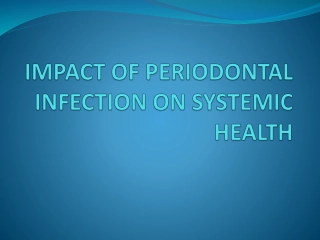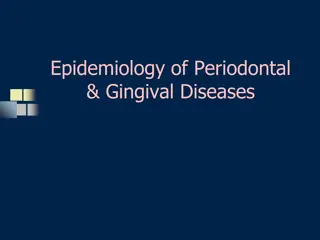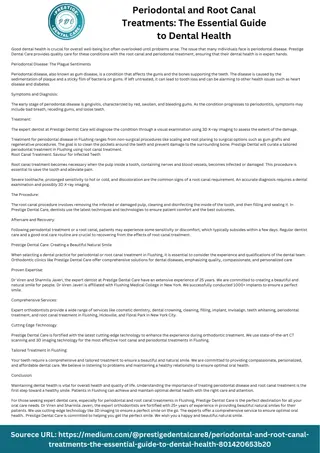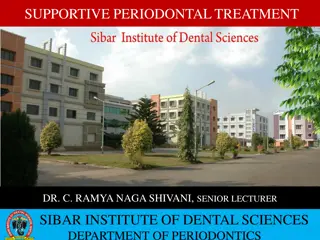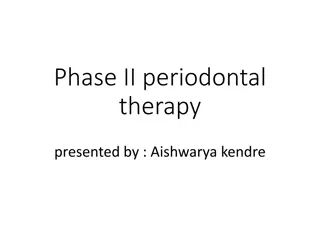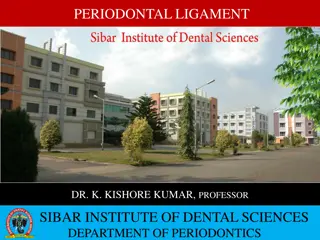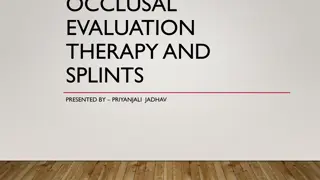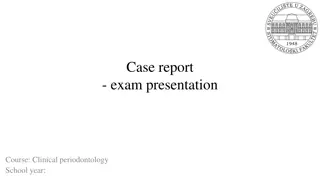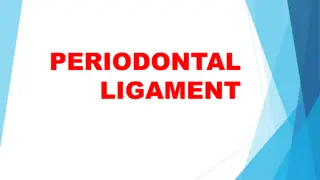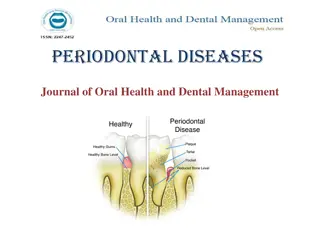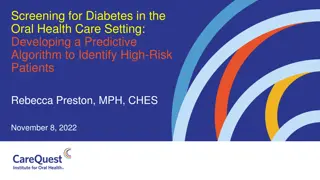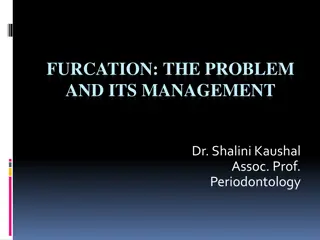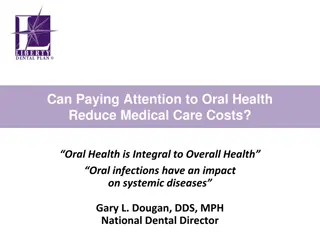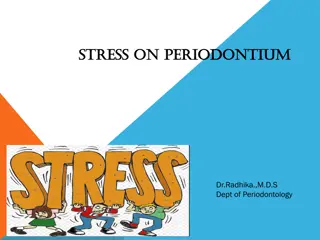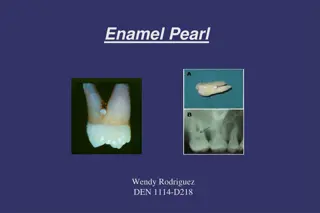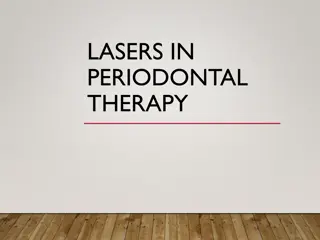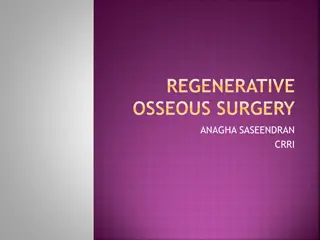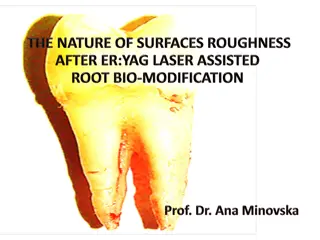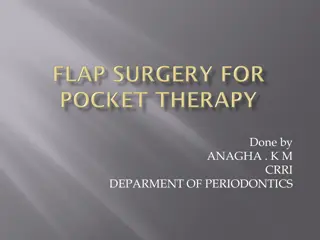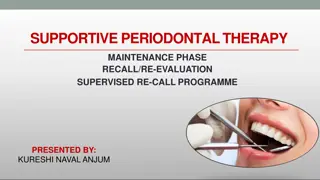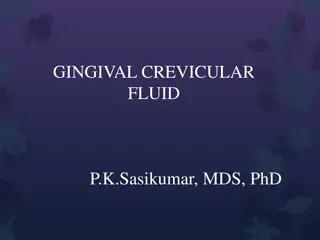Uncovering the Impact of Periodontal Disease on Health
Delve into the interconnected relationship between periodontal disease and mortality, coronary heart disease, stroke, diabetes, pregnancy, COPD, and acute respiratory infections to enhance awareness and understanding for better health outcomes.
2 views • 46 slides
Understanding the Natural History of Disease Development and Prevention
The natural history of disease development outlines the progression of a disease in an individual without intervention, from exposure to outcome. Learning objectives include defining prevention terms, understanding disease severity, prevention levels, and intervention measures. Studying disease prog
4 views • 16 slides
Periodontal Treatment Considerations for Medically Compromised Patients
Patients with significant medical conditions may require special considerations for periodontal treatment. Medical issues such as hemorrhagic disorders, renal diseases, liver diseases, pulmonary diseases, infectious diseases, pregnancy, medications, and cancer therapies can impact oral health and tr
1 views • 87 slides
Epidemiology of Periodontal & Gingival Diseases
Epidemiology is the study of disease distribution and determinants in populations for effective control and prevention. It plays a crucial role in understanding the prevalence, risk factors, and effectiveness of preventive measures for periodontal and gingival diseases. Classification systems and th
3 views • 63 slides
Periodontal and Peri-Implant Surgical Anatomy Overview
Sound knowledge of the anatomy of the periodontium and surrounding tissues is essential for successful periodontal and implant surgical procedures. This includes understanding the mandible and maxilla anatomy, muscles, anatomic spaces, and landmarks like the mandibular canal. Proper awareness can he
9 views • 41 slides
Periodontal and Root Canal Treatments The Essential Guide to Dental Health
Discover expert periodontal treatment at Prestige Dental Care in Flushing. Our skilled team provides advanced care to maintain healthy gums and prevent gum disease. For detailed information on our services and personalized treatment plans, download the PDF now and take the first step towards optimal
1 views • 1 slides
Europe Clear Aligners Market Appliocation: to be Worth $5.43 Billion by 2030
Malocclusion is the third most common oral health problem globally, following periodontal disease and tooth decay. According to the European Journal of Pediatric Dentistry 2020 data, between 2009 and 2019, the global prevalence of malocclusion was 56%. Africa had the highest prevalence (81%), follow
0 views • 4 slides
Principles of Epidemiology: Understanding Disease Occurrence and Surveillance
Epidemiology is the study of disease patterns, factors influencing disease occurrence, and the core functions of surveillance, field investigation, and analytic studies. It involves understanding disease characteristics, natural history, and evaluating the effectiveness of activities to mitigate dis
1 views • 25 slides
Understanding Supportive Periodontal Treatment in Periodontics
Supportive Periodontal Treatment (SPT) is a crucial phase in periodontal therapy aimed at preventing disease recurrence and tooth loss. It involves regular maintenance and monitoring to manage periodontal conditions effectively. SPT includes thorough examinations, radiographic reviews, and prophylax
1 views • 61 slides
Insights into Tyzzer's Disease: An Overview of a Bacterial Infection in Laboratory Animals
Tyzzer's disease is an acute bacterial infection affecting rodents and rabbits, caused by Clostridium piliforme. Discovered in 1917 by Ernest Tyzzer, the disease is characterized by necrotic lesions in the caecal mucosa, liver, and heart. Initially known as Bacillus piliformis, it was later renamed
2 views • 21 slides
Comprehensive Overview of Phase II Periodontal Therapy
Explore the phases, objectives, and treatment methods of Phase II periodontal therapy, including surgical interventions, pocket therapy, and indications for surgery. The treatment plan involves emergency care, nonsurgical therapy, surgical procedures, restorative treatments, and maintenance protocol
1 views • 47 slides
Understanding Disease Control and Prevention in Epidemiology
This article discusses disease control processes in epidemiology, including reducing disease incidence, duration, and transmission. It covers public policy interventions, elimination, eradication, and extinction of infectious agents. It also highlights preventable causes of disease and different lev
2 views • 10 slides
Understanding the Defense Mechanism of Gingiva and Collection of Gingival Crevicular Fluid
Explore the intricate defense mechanisms of the gingiva against bacterial aggression and mechanical trauma. Learn about the collection methods and analysis of gingival crevicular fluid for understanding periodontal health. Discover the composition, role, and permeability of compounds in the gingival
0 views • 41 slides
Understanding the Periodontal Ligament in Dental Sciences
The periodontal ligament (PDL) is a vital connective tissue that supports teeth by attaching them to the jaw bone. It consists of various tissues including cementum and alveolar bone, and is rich in vascular and cellular components. The development of PDL fibers plays a crucial role in tooth support
1 views • 39 slides
Understanding Occlusal Evaluation, Therapy, and Splints
Occlusal evaluation, therapy, and splints play a crucial role in assessing and treating occlusal function and dysfunction. The relationship of occlusion to periodontal health, forces during jaw movements, and the biologic basis of occlusal function are discussed. The importance of balancing occlusio
0 views • 48 slides
Comprehensive Clinical Periodontology Case Study Presentation
This comprehensive clinical periodontology case study presentation includes detailed information on the patient's general and dental history, oral hygiene assessment, periodontal diagnostics, radiographic analysis, occlusion evaluation, periodontal risk assessment, diagnosis, therapy plan, surgical
0 views • 15 slides
Oral Manifestations of Systemic Diseases in Dentistry
This content explores various systemic diseases and their oral manifestations relevant to dentistry. It covers associations between heart disease and periodontal disease, effects of chronic corticosteroid use on the pulmonary system, endocrine disorders like diabetes and thyroid issues, autoimmune d
1 views • 63 slides
Screening for Peripheral Vascular Disease in Patients with Coronary Artery Disease
Patients with coronary artery disease should be screened for peripheral vascular disease as it is a frequent integrator of global cardiovascular risk. The association of atherosclerosis in various arterial diseases highlights the importance of identifying multisite artery disease. The prevalence and
0 views • 23 slides
Understanding Periodontal Ligament: Composition, Functions, and Structure
The periodontal ligament (PDL) is a complex tissue that surrounds a tooth root and connects it to the alveolar bone. It plays a crucial role in tooth support and function. This comprehensive guide covers the composition, principle fibers, blood supply, nerve supply, and lymphatic drainage of the PDL
2 views • 33 slides
Understanding Periodontal Diseases and Their Management
Periodontal diseases affect the supporting structures of teeth and can be caused by bacterial plaque accumulation and host immunological factors. Types of periodontal diseases include gingivitis, herpetic gingivostomatitis, acute necrotising gingivitis, periodontitis, and aggressive periodontitis. P
0 views • 10 slides
Understanding the Impact of Nutrition on Periodontal Disease
Periodontal disease, like caries, is multifactorial and influenced by the balance between bacterial challenge and host defense. Nutritional factors play a subtle but significant role in maintaining periodontal health. A deficiency in nutrients can adversely affect the periodontal tissues and modify
0 views • 23 slides
Integrating Oral Health Screening for Diabetes Risk in Primary Care
This presentation discusses the importance of screening for diabetes risk in oral health care settings through the development of a predictive algorithm to identify high-risk patients. Medical-dental integration is highlighted as a model of care that supports individual and population health by inco
2 views • 16 slides
Understanding Furcation: Management Strategies in Periodontology
Furcation involvement in periodontal disease presents a challenging area to treat due to its complex anatomy. This article discusses the definition, anatomical considerations, Glickman's classification, therapy objectives, selection of therapeutic modes, therapeutic classes, and treatment techniques
0 views • 34 slides
The Impact of Oral Health on Overall Health and Medical Care Costs
Oral health plays a crucial role in overall health, with oral infections affecting systemic diseases. Dental disease management programs are now standard in quality assurance services, as conditions like arthritis, diabetes, and cardiovascular diseases are linked to dental issues. Periodontal diseas
3 views • 26 slides
Understanding the Impact of Stress on Periodontal Health
Periodontitis is a complex disease influenced by various factors, including stress. Chronic stress can negatively affect the immune response, leading to periodontal breakdown. This article explores the relationship between stress and periodontal health, discussing the mechanisms of action, effects o
2 views • 47 slides
Understanding Enamel Pearl Anomaly in Dentistry
Enamel Pearl is a developmental anomaly where small nodules of enamel form below the cemento enamel junction, mainly on permanent teeth. This anomaly, detected radiographically, can lead to bacterial accumulation, periodontal issues, and inflammation if left untreated. Dental hygienists play a cruci
0 views • 8 slides
Understanding Lasers in Periodontal Therapy
Laser technology in periodontal therapy harnesses the energy of photons to provide precise and effective treatment. Originally developed as MASER, the laser produces monochromatic, coherent light with unique properties such as directionality. Key components include the active medium, power supply, a
4 views • 58 slides
Understanding Regenerative Osseous Surgery in Periodontal Therapy
Regenerative osseous surgery is a procedure aimed at reshaping the alveolar bone to correct deformities caused by periodontal disease. This comprehensive guide covers the definition, types, indications, and contraindications of osseous surgery, emphasizing the goal of achieving ideal periodontal reg
0 views • 26 slides
Understanding Root Surface Modifications in Periodontal Therapy
Periodontal therapeutic modalities focus on root surface modifications due to periodontitis, which involves physical, chemical, and cytotoxic changes. Successful outcomes depend on factors like clot stability, cell migration, attachment, proliferation, and debridement. Analyzing cementum properties
0 views • 6 slides
Understanding Periodontal Flap Techniques
Explore the classification and techniques of periodontal flaps for pocket therapy, including modified Widman flap, undispaced flap, and more. Learn about the importance of flap thickness, bone exposure, flap placement, and flap design in periodontal surgery. Discover the different types of pockets a
0 views • 25 slides
Human Disease Symptom Network: Understanding Disease Relationships Through Symptoms and Genes
The Human Disease Symptom Network (HSDN) is constructed using a large-scale medical bibliographic records database to form a network of human diseases based on symptom similarities. By integrating disease-gene associations and protein-protein interaction data, correlations between symptom similarity
0 views • 37 slides
Understanding Bacterial Diseases of Fish: Columnaris Disease Overview
Columnaris disease, also known as Saddleback disease, is a common bacterial infection in fish that is often brought about by poor handling and high stress levels. This disease manifests as tail and fin rot, leading to rapid fish mortality. The causative organism, Cytophaga (formerly Flexibacter), is
0 views • 21 slides
Decoding Genetics: Insights from Alzheimer's Disease Symposium to Type 2 Diabetes Study
Explore the latest findings from the Alzheimer's Disease Genetics Symposium 2019 on disease mechanisms, drug targets, and genetic pathways. Dive into the progress made by the Alzheimer's Disease Genetics Consortium over the past decade. Transition to a Genome-Wide Association Study uncovering suscep
0 views • 42 slides
Liver Disease Burden in Tower Hamlets
Dr. Somen Banerjee, Director of Public Health in London Borough Tower Hamlets, highlights the concerning liver disease mortality rates in the area, with high incidence of cirrhosis, cancer, and hepatitis B and C. The data reveals a significant burden of liver diseases such as Non-Alcoholic Fatty Liv
0 views • 18 slides
Understanding Inflammatory Bowel Disease: Crohn's Disease and Ulcerative Colitis
Inflammatory Bowel Disease (IBD) encompasses Crohn's disease (CD) and ulcerative colitis (UC), chronic conditions with immunologic basis. This article delves into the epidemiology, pathophysiology, and differences between CD and UC, highlighting clinical features, pathology, and complications like a
0 views • 42 slides
Supportive Periodontal Therapy: Maintenance and Supervision Overview
Supportive Periodontal Therapy (SPT) is a critical phase in periodontal care designed to assist patients in maintaining oral health, prevent disease recurrence, and preserve bone support. It involves a series of procedures performed at intervals to support the patient's efforts in controlling and av
0 views • 34 slides
Understanding Gingival Crevicular Fluid in Oral Health
Gingival crevicular fluid (GCF) is a crucial component in periodontal health, serving various functions such as cleansing the sulcus, enhancing epithelial adhesion, possessing antimicrobial and antibody properties. Factors influencing GCF production include capillary filtration and lymphatic uptake
0 views • 46 slides
Understanding Bone Destruction in Periodontal Disease
The progression of periodontal disease can lead to bone destruction in the alveolar bone, which is crucial in supporting teeth. The inflammatory process causes permanent damage to the periodontium tissues, resulting in connective tissue loss and bone resorption. Different patterns of bone loss, such
0 views • 14 slides
Understanding Biological Changes with Light or Heavy Forces Application
Tooth movement can be categorized as physiologic, pathologic, or orthodontic, with forces transmitted through the tooth to the periodontal ligament and alveolar bone. Changes occurring due to light and heavy forces result in bone resorption and deposition, impacting the supporting structures. Histol
0 views • 25 slides
Ultrastructural Alterations of Renal Tissue in a Male Patient with Fabry's Disease
Fabry's disease is a rare X-linked lipid storage disorder characterized by deficient lysosomal alpha-galactosidase A activity. This condition primarily affects males, leading to chronic kidney disease and progression to end-stage renal disease. Kidney involvement is a critical aspect, and high doses
0 views • 24 slides
